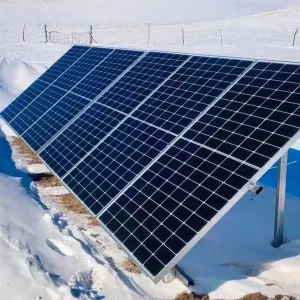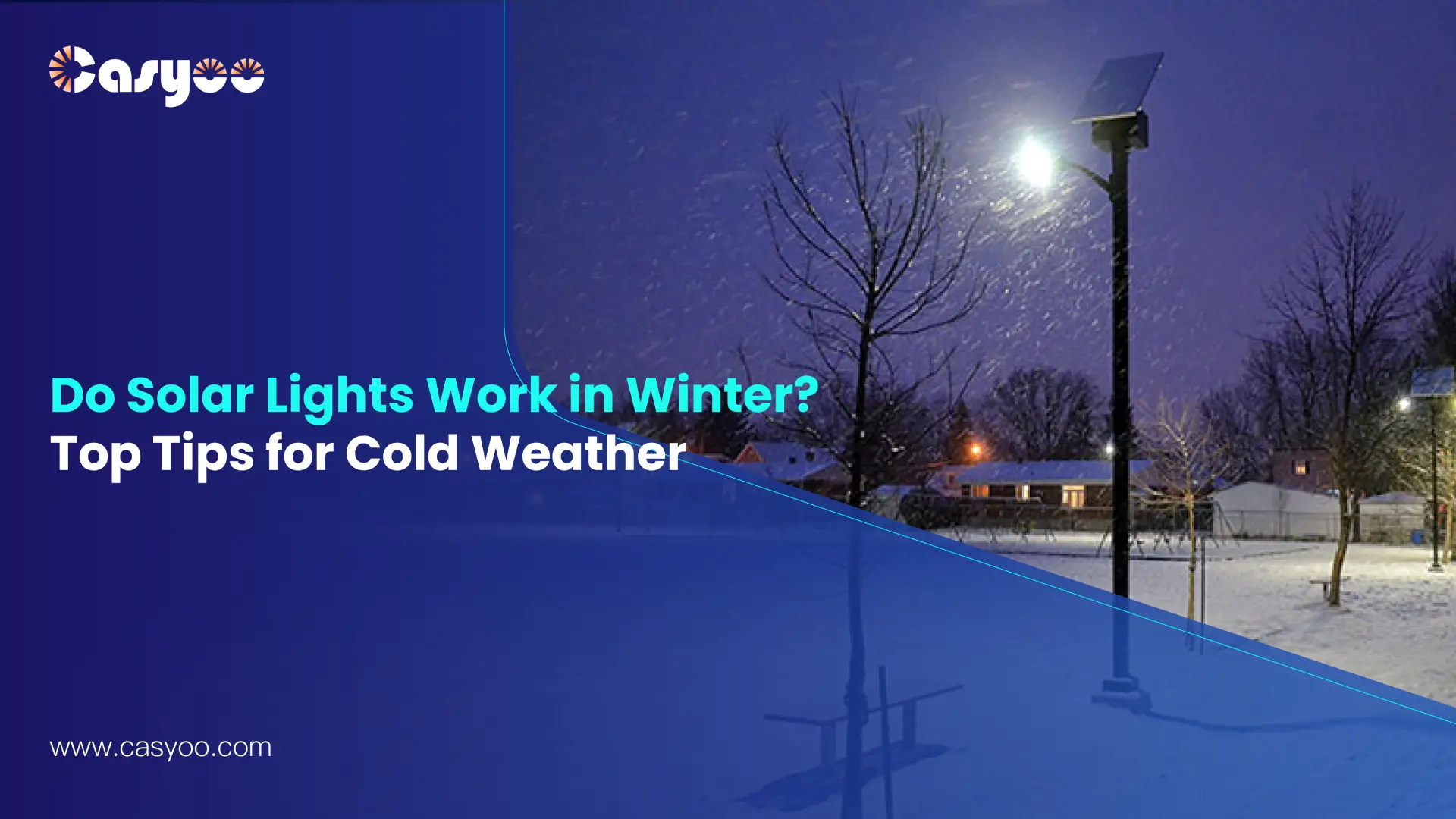As temperatures drop and the days become shorter, many people wonder if solar lighting can work properly in winter. The quick answer is that solar lights work in the winter; nevertheless, their performance is dependent on the quality of engineering design and installation methods.
The winter performance of solar lights incorporates several interesting scientific facts. For example, LED lights function better in colder temperatures. Published research on LED performance reveals that these lights can be up to 5% more efficient at temperatures around 0°C than at 25°C.
Understanding the Winter Solar Challenge
Winter provides three major problems to solar lighting: shorter days, less sunlight, and colder temperatures. However, advancements in solar technology have resulted in particular solutions to each of these difficulties.
A solar lamp functions similarly to a hybrid car in that it absorbs energy when conditions are suitable and stores it for later use. A well-designed solar lamp, like a hybrid vehicle, continues to perform even when conditions are less than perfect.
Advanced Solar Technology
Modern photovoltaic technology has advanced tremendously in recent years. Independent efficiency studies have shown that high-efficiency solar panels can sustain up to 50% of their charging capacity on overcast winter days. Dual-panel technology has improved this capability, allowing for better light capture throughout the winter months when the sun goes lower across the sky.
Improvements in materials science and panel design have led to increased solar efficiency. Modern panels use improved silicon crystal structures to capture a wider range of light energy. Multi-layer coating technologies reduce surface reflection, allowing more photons to enter the energy-converting layers below.
Cold Weather Performance
Winter temperatures pose particular obstacles to battery performance. Recent research published in the Journal of Power Sources (2023) reveal that lithium-ion batteries retain approximately 80% of their capacity at 0°C, decreasing to 55-60% at -20°C. However, new electrolyte compositions can increase low-temperature performance by 15-20%.
Winter Operating Duration
Battery performance in the winter follows seasonal trends. According to recorded requirements, premium lithium batteries can withstand around 600 charging cycles. Winter operation often results in lower run times due to shorter charging intervals and higher energy demands. The real time varies on local daylight hours, weather, and system characteristics.
System Lifespan
Cold weather affects each system component differently. LED components are typically efficient throughout their rated lifespan of 50,000+ hours, regardless of season. However, environmental conditions have a considerable impact on system lifespan. Regular exposure to temperatures below -20°C has the potential to accelerate battery degradation, but adequate thermal management and charge control systems can help limit the consequences.
Critical Winter Specifications
When it comes to winter performance, certain technical criteria are critical. Any outdoor solar lighting system should have an IP65 or above waterproof grade to protect against snow and ice. To ensure successful winter operation, the temperature operating range must be extended to at least -20°C. For battery capacity, we recommend a minimum of 2000mAh for residential applications and 5000mAh for commercial installations. Panel efficiency should never drop below 15% conversion rate.
Installation Strategies
The efficiency of winter solar lighting is heavily dependent on installation technique. Technical requirements specify that the best panel angle during the winter months should be between 45 and 60 degrees, depending on latitude. This location provides two functions: increasing light exposure and allowing natural snow removal.

The mechanics of solar panel positioning include both direct and reflected light capture. The steeper winter angle compensates for the sun’s lower position while also utilizing snow’s reflecting characteristics. Snow-covered ground can actually enhance available light via the albedo effect, in which sunlight reflects off the snow surface and hits the panel from several angles.
Location Optimization
Positioning has a big impact on winter performance. During the northern hemisphere’s winter, south-facing installations receive more sunshine. Strategic placement, taking into account shading patterns and local weather conditions, can significantly improve charging efficiency.
The significance of correct positioning goes beyond just solar exposure. Factors such as wind patterns influence snow buildup and natural clearance. Local topography affects both direct sunshine hours and ambient light reflection. Understanding these site-specific features improves system performance throughout the winter season.
Winter Charging Tips for Solar Lights
Winter conditions frequently cause anxiety regarding the performance of solar lighting. However, technological developments now allow for successful charging even with limited daylight. Here’s what you should know:
1. How Do Solar Lights Charge in the Winter?
Modern solar lights use high-efficiency panels that can generate enough electricity with only 4-5 hours of winter daylight. Many also use dual-spectrum technology, which captures both visible and infrared photons, improving performance in low-light circumstances.
2. Do Solar Lights Charge on Cloudy Days?
Yes, they can. New solar panels can collect energy from scattered and reflected light, allowing for charging even on cloudy days. In overcast conditions, advanced models can improve efficiency by up to 25%.
3. Do solar lights require direct sunlight?
Direct sunlight is best for greatest efficiency, although new solar lights can also charge under dispersed sunlight. Panels are meant to capture a wide range of light, including both indirect and ambient light.
Winter Maintenance Essentials
Regular maintenance is critical for optimal winter performance. Beyond basic snow removal, professional systems require systematic maintenance to function optimally. Understanding the relationship between maintenance practices and system performance is important for ensuring reliable operation throughout the winter season.
The maintenance regimen starts with preventive steps before winter hits. This includes inspecting and sealing all weather-sensitive components, checking the battery’s condition, and calibrating the light sensors. Regular monitoring during winter operation aids in the detection of possible issues before they have an impact on system performance.
Key maintenance methods should adhere to an organized approach:
For snow and ice management:
- To manage snow and ice, rapidly remove accumulation to avoid disruptions to energy gathering.
- Use soft brushes to protect panel surfaces from scratches and damage.
- Maintain appropriate panel tilt for natural snow shedding.
- Inspect panel edges for ice dam formation.
For system optimization:
- Monitor performance metrics using automated systems.
- Clean panels regularly using proper procedures.
- Examine weather seals for probable degradation.
- Verify sensor functionality and calibration.
The scheduling of maintenance work is especially crucial in winter circumstances. Morning checks enable for the resolution of any overnight issues before they disrupt daily charging cycles. Regular monitoring of system performance measures aids in detecting slow degradation that might otherwise go unnoticed.
Common Winter Challenges and Solutions
Winter operations bring distinct challenges that necessitate tailored solutions. Insufficient charging or incorrect panel angles are common causes of reduced operational time. In one commercial installation, changing the panel angle increased running time by 40%. Inconsistencies in the system usually signal a problem with the battery’s health or inadequate charging cycles.
Performance Optimization
Temperature variations have a substantial impact on system performance. Professional-grade systems use temperature compensation technology to automatically modify charging parameters based on ambient conditions. This adaptive technique ensures consistent performance under different winter circumstances.
Selecting the Right System
Choosing adequate solar illumination necessitates thorough analysis of unique application scenarios. Commercial installations, such as parking lots and paths, require industrial-grade systems with professional monitoring capabilities. These systems should have a minimum lifespan of ten years and have backup power for important applications.
For home applications, look for systems that are easy to maintain and have smart charging capabilities. Motion sensor integration can considerably increase battery life by adjusting power consumption based on actual lighting requirements.
Technology Innovations
Solar lighting is a rapidly evolving business. Recent advances include self-cleaning panel surfaces that require less maintenance and improved cold-weather battery chemistry for better winter performance. AI-powered management solutions now provide predictive maintenance by automatically altering system parameters depending on weather forecasts.
Cost Considerations
Professional-grade solar lighting systems cost a larger initial investment, but they often provide better long-term value due to increased reliability and lower maintenance requirements. Our research shows that with regular maintenance, superior systems may provide continuous performance for 10 years or more, but consumer-grade alternatives only last 2-3 years.
Conclusion
Yes, solar lights can be effective in the winter if they are properly planned and installed. Advanced solar panels, clever battery management, and optimum installation procedures all help to overcome problems such as shorter daylight hours, lower sunshine, and colder temperatures. High-quality systems function consistently even in difficult environments and can endure for more than a decade with regular maintenance.
When selecting a solar lighting option for winter use, look for professional-grade devices designed for cold weather operation. Contact our technical team for specialized advise and reliable performance on your individual solar lighting needs.




